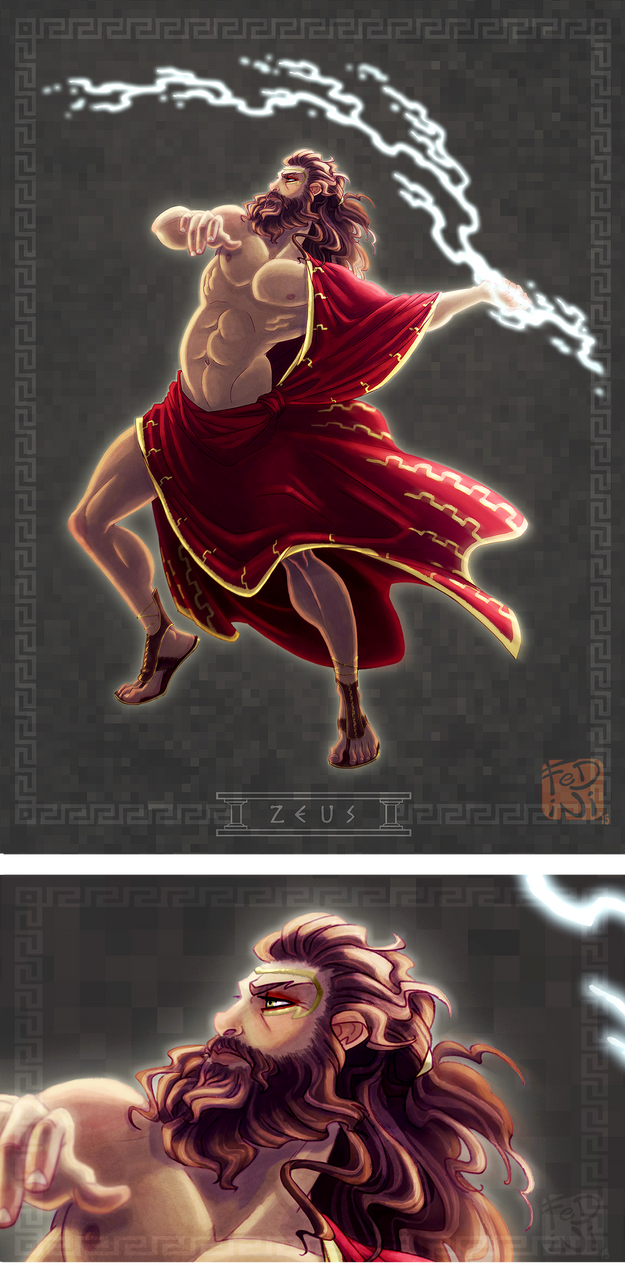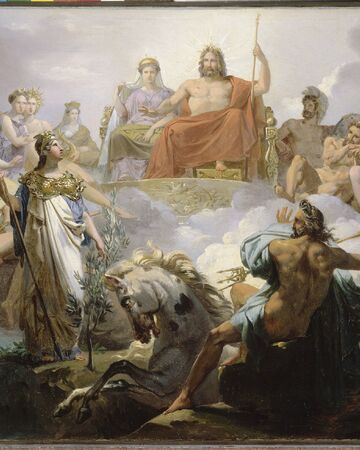Heraall About Myths
Portrayal and Symbolism
The Mythical Story of Hera Hera, the eldest daughter of Cronus and Rhea, was born at Samos, or, according to some accounts, at Argos, and was reared by the sea-divinities Oceanus and Tethys, who were models of conjugal fidelity. From fruits to winged sandals, test your knowledge in this study of Greek and Roman mythology. In general, Hera was worshipped in two main capacities: (1) as consort of Zeus and queen of heaven and (2) as goddess of marriage and of the life of women.
Hera was usually portrayed alongside Zeus, as a fully clothed matronly woman of solemn beauty, wearing a cylindrical crown called polos or a wreath and a veil. Sometimes she carries a scepter capped with a pomegranate and a cuckoo – the former a symbol of fertility, the latter a token of the way she was wooed by Zeus. She is also often accompanied by a peacock, one of her sacred animals.
Epithets
Homer often refers to Hera as “cow-eyed” and “white-armed” – which are her most famous epithets. She is also sometimes called “a virgin,” since it was believed that every year she bathed in a spring to renew her virginity.
Heraall About Myths Definition
Family
Being born after Hestia and Demeter, Hera is the youngest of Cronus’ and Rhea’s three daughters and their third child overall; Hades, Poseidon, and Zeus – in that order – are her younger brothers. However, since just like each of her siblings but Zeus, she was swallowed by her father at birth and later disgorged to be born again, she is sometimes referred to as Cronus’ and Rhea’s oldest daughter. Reasonably, since the Titan had to empty his stomach of his children in the order opposite of the one in which he ate them.
The Archetypal Married Couple: Hera and Zeus
As the guardian of marriage and the spouse of the King of Gods and Men, Hera didn’t have much choice but to be a faithful wife. Even though she was beautiful, not many men – and not one god – dared to lay hands on her. Endymion tried once, but Zeus condemned him to eternal sleep. Ixion fared even worse: Zeus fooled him into making love with a cloud fashioned in Hera’s image, and then ordered Hermes to bind him to a perpetually turning wheel of fire.
By most accounts, Hera gave Zeus four children: Ares, the god of war, Eileithyia, the goddess of childbirth, Hebe, the goddess of eternal youth, and Hephaestus, the god of fire.
Hera, a Vengeful Wife
The Wooing of Hera
Zeus tricked Hera into marriage. Knowing full well that the goddess loved animals, he transformed himself into a distressed cuckoo and reverted to his original form only when Hera took the poor creature to her breast to warm it. Ashamed for being taken advantage of, Hera agreed to a marriage.
Hera Challenges Zeus
However, it didn’t turn out to be a happy one. Zeus was brutish and cruel to everybody. Incapable of bearing this, Hera plotted a revenge plan with Poseidon, Athena and possibly few other gods. She drugged Zeus, and they bound him on his bed, while stealing his thunderbolt. Thetis, however, summoned Briareus and he managed to quickly untie Zeus, who was, subsequently, merciless to the main schemer: he hung Hera from the sky with golden chains.
To grant herself a release, Hera swore to never rebel again against her husband. So, she directed her anger toward Zeus’s lovers and their offspring, becoming a jealous and vindictive wife.
Hera and Semele
For example, she tricked Semele into forcing her lover – which she knew was Zeus – to reveal himself before her in all his glory. Since humans can’t look upon at gods without incinerating, Semele perished into thin air.
Hera and Callisto
Later, she turned Callisto into a bear, after the latter gave birth to Zeus’ child Arcas. After some time, just as Arcas was about to unwittingly kill his mother, Zeus placed Callisto and her son in the sky as the constellations Ursa Major and Ursa Minor, the Big and the Little Bear.
Hera and the Delaying of Births
Hera kept her daughter Eileithyia from attending the birth of Apollo, postponing it by nine days and nights. More famously, she did the same with Heracles; in this case, the delay caused Heracles the throne of Argolid.
Hera and Io
Arguably, Io was the one who endured the most. First Zeus transformed her into a cow so that he can hide her from Hera. Then, Hera sent Argus Panoptes to watch over her, and Zeus – Hermes to kill him. After that, Hera transformed Argus’ ghost into a gadfly which bothered Io in her bovine form all the way to Egypt. Finally, Zeus impregnated her there with Epaphus.
Hera, the Vain Goddess
Just like most of the other Greek goddesses, when it came to her beauty, Hera was easily offended.
Once, Orion’s wife Side (“pomegranate”) boasted that she was as beautiful as Hera, so the goddess sent her to the Underworld. When Laomedon’s daughter Antigone did the same, Hera turned her into a stork. Finally, after Paris chose Aphrodite instead of her, she became a sworn enemy of Troy.
Sources
Check out “The Homeric Hymn to Hera”: it is merely five verses long. If you wish, you can find out more about Io in the second half of Aeschylus’ “Prometheus Bound” and the First Book of Ovid’s “Metamorphoses.”
See Also: Zeus's Lovers, Hecatoncheires, Zeus, Oceanus, Tethys
Hera Q&A
Who was Hera?
Hera is the wife of Zeus, the Queen of Olympus, and the Olympian goddess of marriage. As such, she is also the deity most associated with family and the welfare of women and children.
What did Hera rule over?
Hera ruled over the Marriage, the Women and the Birth.

Where did Hera live?
Hera's home was Mount Olympus.
Who were the parents of Hera?
The parents of Hera were Cronus and Rhea.
Who were brothers and sisters of Hera?
Hera had 6 siblings: Poseidon, Hades, Demeter, Hestia, Zeus and Chiron (half brother).
Who was the consort of Hera?
Hera's consort was Zeus.
How many children did Hera have?
Hera had 5 children: Ares, Hebe, Eileithyia, Hephaestus and Eris.
Which were the symbols of Hera?
Hera's symbols were the Royal Sceptre and the Diadem.
Which were the sacred animals of Hera?
Hera's sacred animals were the Cow, the Lion, the Cuckoo, the Peacock and the Panther.

Which were the sacred plants of Hera?
Hera's sacred plants were the Lily, the Pomegranate and the Lotus.
Greek Goddess of Marriage and Queen of Olympus
Hera is the Queen of the Gods and is the wife and sister of Zeus in the Olympian pantheon. She is known for being the Goddess of Marriage & Birth. Despite being the Goddess of Marriage, she was known to be jealous and vengeful towards the many lovers and offspring of her husband Zeus.
She was also known to turn her anger towards mortals who crossed her as well – for example, Paris, who chose Aphrodite over Hera as the most beautiful goddess at the marriage of the sea-nymph Thetis to a mortal called Peleus.
In images and statues, Hera is portrayed as being majestic and solemn, crowned with the polos – a high cylindrical crown worn by many of the Great Goddesses.
Even before her marriage with Zeus, she ruled over the heavens and the Earth. This is one reason why she is referred to as ‘The Queen of Heaven’ – ruling over Mount Olympus where all the gods and goddesses live.
Even the great Zeus feared his wife Hera. Her never-ending hatred of Heracles, the illegitimate son of Zeus and the mortal Alcmene stemmed from his continuous adultery and, amongst other things, Hera raised a storm at sea in order to drive Heracles out of his course to kill him.
Famous Myths Of Hera
Zeus became so angry that he hung her in the clouds by a golden chain, and attached heavy anvils to her feet. Her son Hephaestus tried to release his mother from her humiliating position, for which Zeus threw him out of heaven, and his leg was broken by the fall.
Facts about Hera
- Hera was Queen of the Olympian gods.
- She was the wife and sister of Zeus.
- Hera was a jealous wife, and she fought with Zeus frequently over his extramarital affairs and illegitimate children. For this reason, Hera was known for punishing offending husbands.
- She was the protector of women, presiding over marriages and births.
- While Hera was worshipped in all parts of Greece, temples were erected in her honor at Argos and Salmos.
- The peacock was sacred to her.
- Hera had few, if any, redeeming qualities. She never forgot an injury.
- The Titans Ocean and Tethys brought her up.
- Hera is often described as “cow-faced,” although she was also called the chief among the immortals in beauty.
- Though she may have been physically attractive, her vindictive personality makes her less so.
- The Trojan War would have ended in peace, but Hera had a vested interest in its outcome and influenced Zeus to either switch sides or remain neutral.
- Hera had no concept of justice when angry or jealous; she could not forgive the women with whom Zeus had sexual relations—even if they were innocent of wrongdoing.
- Ilithyia, a daughter of Hera’s, assisted women in childbirth.
- In the story of the Quest of the Golden Fleece, Hera was a gracious protector of the heroes.
- Paris awarded Aphrodite the Golden Apple over Athena and Hera.
- Hera punished one of Zeus’s love interests, Io, by putting her in the charge of Argus. Argus had a hundred eyes and kept vigilant watch over her so that Zeus could not come to her aid.
- Hera turned Callisto into a bear because Zeus fell in love with her.
- Hera arranged the death of Semele, another of Zeus’s mortal conquests, although she did not directly cause it.
- Hera never forgave Hercules for being Zeus’s son, but when Hercules died and was taken to heaven, he and Hera reconciled. While in heaven, Hercules married Hera’s daughter Hebe.
- In some stories, it was at Hera’s orders that Dionysus was torn to pieces. He was brought back to life, and it is this resurrection that was celebrated in theatres.
Link/cite this page
If you use any of the content on this page in your own work, please use the code below to cite this page as the source of the content.

Link will appear as Hera: https://greekgodsandgoddesses.net - Greek Gods & Goddesses, September 19, 2014
